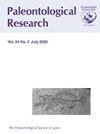日本北海道仓马须奈更新世Setana组中的五种微孔虫(Bryozoa,Cheiloporta)
IF 0.6
4区 地球科学
Q3 PALEONTOLOGY
引用次数: 0
摘要
摘要对北海道西南部更新世Setana组Soebetsu砂岩段的小孔虫化石进行了研究。对粳稻Canu和Bassler进行了描述,并对sakakurai、minuta、quadristoma和soebetsuensis等4种进行了新描述。其中一些以前被报道为M. articulata (Fabricius)。在这五种中,有三种(日本、樱井、minuta)有半椭圆形或椭圆形的孔口,相对较大和较深的正面假孔,小孔被薄板封闭,表面呈静脉状雕刻,avicularia长而宽。另外两种(M. quadristoma, M. soebetsuensis)有一个圆形的方形孔(有时近缘凸),较小的正面假孔,小孔闭塞但缺乏静脉状表面雕刻,和avicularia圆形或宽于长。在sakakurai和soebetsuensis两个物种中观察到明显的口型二态性。本文章由计算机程序翻译,如有差异,请以英文原文为准。
Five Species of Microporina (Bryozoa, Cheilostomata) from the Pleistocene Setana Formation at Kuromatsunai, Hokkaido, Japan
Abstract. Fossils of Microporina species were collected and examined from the Soebetsu Sandstone Member of the Pleistocene Setana Formation in southwestern Hokkaido. A description is provided for M. japonica Canu and Bassler, and four species (M. sakakurai, M. minuta, M. quadristoma and M. soebetsuensis) are newly described. Some of them were previously reported as M. articulata (Fabricius). Among the five species, three (M. japonica, M. sakakurai, M. minuta) have a semielliptical or elliptical orifice, relatively large and deep frontal pseudopores, opesiules occluded with a thin plate showing vein-like surface sculpturing, and avicularia that are longer than wide. The other two (M. quadristoma, M. soebetsuensis) have a rounded-quadrate orifice (sometimes with a convex proximal margin), smaller frontal pseudopores, opesiules occluded but lacking vein-like surface sculpturing, and avicularia that are circular or wider than long. Marked orificial dimorphism is observed in two species, M. sakakurai and M. soebetsuensis.
求助全文
通过发布文献求助,成功后即可免费获取论文全文。
去求助
来源期刊

Paleontological Research
PALEONTOLOGY-
CiteScore
1.60
自引率
0.00%
发文量
47
审稿时长
>12 weeks
期刊介绍:
Paleonotological Research (PR) is a quarterly, peer-reviewed international journal, which focuses on original contributions primarily in the area of paleontology but also covering a wide range of allied sciences. It has been published since 1997 as a successor to the former journal Transactions and Proceedings of the Palaeontological Society of Japan. The emphasis of contributions will include global and local perspectives, and contents can cover all ages (Precambrian to the Quaternary, including the present time).
 求助内容:
求助内容: 应助结果提醒方式:
应助结果提醒方式:


